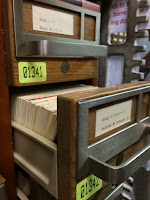My week at the Library of Congress Summer Institute for Civil Rights has been one of the best weeks of professional development I've experienced. I will not lie, it was extremely intense! I am certain I used up every ounce of brain juice. The analysis of primary sources was a total hook for an organic engagement of inquiry, collaboration and reflection.
Using the Project Zero thinking routines as a framework, each analysis activity had us actively invested in the process in so many different ways.
I was fortunate that I was familiar with the routines and had attended a Project Zero Casie conference all about thinking routines just 3 months before attending the Institute. Visible thinking strategies provide a framework to prompt students to be deep thinkers and synthesize new knowledge. The visible thinking, most importantly, shows the process of thinking not just a final answer. The book provides a menu of critical thinking activities that work with just about any learning opportunity. It's a wonderful way to keep the learning low-risk and open-ended. Visible thinking strategies also dovetailed perfectly with the analysis of primary sources. Some of the routines we used while analyzing primary sources were Headlines (great for synthesis) and Circle of ViewPoints (powerful way to tackle perspectives).
 |
| Map Group Activity Ending with a Creation of a Headline |
Another automatic go-to are the Library of Congress primary source analysis tools which scaffold the inquiry process for just about any possible primary source. There is also a web version available.
One of the perks to attending the Institute was the after hours tour of the Jefferson Building's Reading Room. We had total VIP access! I wish I could have bottled up the excitement as we entered the Reading Room, total giddiness. It reminded me of just a few months ago when I was at the Washington Memorial with eighty 8th grade students, and we ran into Usher doing a soundcheck for an Earth Day concert.
We also had the incredible fortune to hear a panel made up of Rosa Parks' dear friends from the Rosa Parks Institute in Detroit: Elaine Steele, Lila Cabbil, Anita Peek, Dr. Roberta McLeod, Ella McCall-Haygen and other friends June Jeffries and Joe Madison. They shared with us Parks' courage and how she valued relationships. The ladies then hung out with us for part of the week. It was a truly surreal experience.
 |
| Ella McCall-Haygen, me & Dr. Roberta McLeod |
 |
| Panel of Rosa Parks' Friends |
One of my favorite parts of the institute was the opportunity to tour the Library of Congress exhibit The Civil Rights Act of 1964: A Long Struggle for Freedom. We were partnered up and were assigned to an exhibit case. We were then asked to select something that we connected with in the case and later present it to the group. We had questions to guide us in the process. It was jigsaw at its best! I'm totally stealing this idea next time we take our students to a museum.
Some of my major primary source takeaways I plan on using to ignite inquiry are:
I walked away from the Summer Institute with a better idea on how to maximize the access/usage of the Library of Congress digital sources. The experience has totally transformed me, and I cannot wait to implement new ideas with my students. I've walked away a better teacher with an arsenal of best practice pedagogy and a passion for learning with primary sources. During the Institute, I was in the company of other educators that share my passion for learning and history! I have a feeling some of those friendships will continue inspiring me beyond our time together in Washington D.C.
Some of my major primary source takeaways I plan on using to ignite inquiry are:
- Focus on the voices behind the movement. I plan on highlighting Bayard Rustin, an openly gay man, that was the mastermind behind the March on Washington but is rarely noted.
- Include raw, unfiltered primary sources throughout the year as much as possible. Coming across a Daisy Bates letter regarding the poor treatments of black students at Central High, specifically mentioning Minniejean (visits our school every year during our Civil Rights unit), I consider hitting the jackpot! There is a goldmine of sources available.
- When teaching about the Civil Rights unit, I plan to include primary sources from slavery, Revolutionary War, to current events to represent the long and still much present struggle of social justice.
- During my Native American unit, I will fold in powerful Indian boarding school primary sources . I'm thrilled that there is actually a "Nashville" connection too. Adding this slice of history makes a connection later on in the year with the Civil Rights unit's focus on school segregation and civil rights violations.
I walked away from the Summer Institute with a better idea on how to maximize the access/usage of the Library of Congress digital sources. The experience has totally transformed me, and I cannot wait to implement new ideas with my students. I've walked away a better teacher with an arsenal of best practice pedagogy and a passion for learning with primary sources. During the Institute, I was in the company of other educators that share my passion for learning and history! I have a feeling some of those friendships will continue inspiring me beyond our time together in Washington D.C.





No comments:
Post a Comment